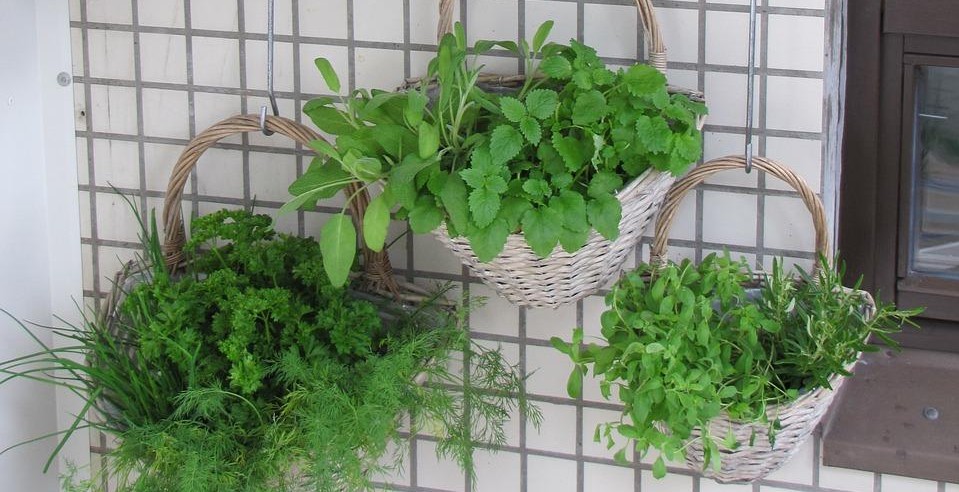How to Build a DIY Vertical Herb Garden
If you love cooking with fresh herbs but don’t have a lot of space, a DIY vertical herb garden may be the perfect solution for you. Not only does it save space, but it also adds a beautiful touch to your outdoor or indoor living space.
Why Build a DIY Vertical Herb Garden?
There are several reasons why you may want to build a DIY vertical herb garden. First, it saves space. If you live in an apartment or have a small backyard, a vertical herb garden can allow you to grow a variety of herbs without taking up too much space. Second, it’s a great way to add greenery and beauty to your living space. Finally, growing your own herbs can save you money in the long run, as fresh herbs can be expensive to buy at the grocery store.
Benefits of a Vertical Herb Garden
Aside from the space-saving benefits, a vertical herb garden has several other advantages. First, it’s easy to maintain and harvest. Because the herbs are grown vertically, you can easily access them without having to bend down or kneel. Second, it can help improve air quality and reduce stress levels. Plants are known to help purify the air and create a calming atmosphere. Third, it’s a fun and creative project that can be customized to fit your personal style and preferences.
Ready to get started on building your own DIY vertical herb garden? Follow our step-by-step guide to create your own beautiful and functional garden.

Materials Needed
1. Wood and Supplies
- 2 Cedar 2x4s, 8 feet long
- 1 Cedar 1×4, 8 feet long
- 1 Cedar 1×6, 8 feet long
- 1 Cedar 1×2, 8 feet long
- 2-inch screws
- 1-inch screws
- Wood glue
- Sandpaper
- Exterior wood stain or paint
2. Tools
- Table saw or circular saw
- Miter saw or hand saw
- Drill
- Countersink bit
- 1/8-inch drill bit
- Level
- Tape measure
- Pencil
- Safety glasses
3. Other Materials
- Landscape fabric
- Staple gun and staples
- Potting soil
- Herb plants or seeds
4. Optional Tools
- Belt sander or sanding block
- Router
- Forstner bit
| Materials | Quantity | Cost |
|---|---|---|
| Cedar 2x4s | 2 | $20 |
| Cedar 1×4 | 1 | $10 |
| Cedar 1×6 | 1 | $15 |
| Cedar 1×2 | 1 | $5 |
| Screws and wood glue | N/A | $10 |
| Sandpaper and exterior stain/paint | N/A | $15 |
| Landscape fabric, staples, potting soil, and herb plants/seeds | N/A | $50 |
| Total Cost | N/A | $125 |
Overall, building a DIY vertical herb garden requires a moderate level of woodworking skills and tools. However, with the right materials and a little bit of patience, anyone can create a beautiful and functional garden that will enhance their outdoor space and provide fresh herbs for cooking and medicinal purposes.

Step-by-Step Guide: How to Build a DIY Vertical Herb Garden
Building a vertical herb garden is a great way to grow herbs, even if you have limited space. This guide will walk you through the six simple steps to build your own vertical herb garden.
Step 1: Plan Your Vertical Herb Garden
Before you start building your vertical herb garden, you need to plan it out. Consider the size of the space where you want to place the garden, the amount of sunlight the area receives, and the types of herbs you want to grow. Draw a rough sketch of your garden to help you visualize the design.
Step 2: Gather Your Materials
Once you have a plan in place, gather all the materials you need. You will need a wooden frame, screws, a drill, a saw, shelves, a staple gun, landscape fabric, potting soil, and your chosen herb plants.
Step 3: Build the Frame
Using your saw and drill, build the wooden frame according to your plan. Make sure the frame is sturdy and level. You can also add legs to the bottom of the frame to make it freestanding.
Step 4: Add the Shelves
Attach the shelves to the frame using screws. Make sure the shelves are level and evenly spaced. You can also add a backing to the frame to prevent soil from falling out of the back.
Step 5: Add the Soil and Plants
Cut pieces of landscape fabric to fit each shelf and staple them in place. This will prevent soil from falling through the shelves. Fill each shelf with potting soil and plant your chosen herbs. Make sure to space the plants appropriately and water them thoroughly.
Step 6: Water and Maintain Your Herb Garden
Water your herb garden regularly to keep the soil moist. You can also add a drip irrigation system to make watering easier. Prune your herbs as needed to keep them healthy and promote growth. With proper maintenance, your vertical herb garden will provide you with fresh herbs all year long.

Best Herbs to Grow in a Vertical Herb Garden
If you’re planning to build a DIY vertical herb garden, it’s essential to choose the right herbs to grow. Here are some of the best herbs to grow in a vertical herb garden:
Basil
Basil is a popular herb that is easy to grow and maintain. It has a sweet and tangy flavor that adds a unique taste to dishes. Basil needs plenty of sunlight and well-draining soil to thrive. It’s best to plant basil in a vertical herb garden during the summer months.
Mint
Mint is a versatile herb that can be used in a variety of dishes, including teas, cocktails, and desserts. It has a refreshing and cooling taste that makes it perfect for hot summer days. Mint prefers partial shade and moist soil, making it an ideal herb to grow in a vertical herb garden.
Thyme
Thyme is a herb that is commonly used in Mediterranean cuisine. It has a warm and earthy flavor that pairs well with meats, vegetables, and soups. Thyme needs full sunlight and well-draining soil to grow. It’s best to plant thyme in a vertical herb garden during the spring or fall months.
Parsley
Parsley is a herb that is rich in vitamins and minerals. It has a fresh and slightly bitter taste that makes it perfect for salads, soups, and sauces. Parsley needs partial shade and moist soil to grow. It’s best to plant parsley in a vertical herb garden during the spring or fall months.
Rosemary
Rosemary is a herb that is commonly used in Mediterranean cuisine. It has a strong and distinctive flavor that pairs well with meats, potatoes, and bread. Rosemary needs full sunlight and well-draining soil to grow. It’s best to plant rosemary in a vertical herb garden during the summer months.
| Herb | Preferred Light | Preferred Soil | Best Time to Plant |
|---|---|---|---|
| Basil | Full Sunlight | Well-draining | Summer |
| Mint | Partial Shade | Moist | Anytime |
| Thyme | Full Sunlight | Well-draining | Spring or Fall |
| Parsley | Partial Shade | Moist | Spring or Fall |
| Rosemary | Full Sunlight | Well-draining | Summer |
Other herbs that are great for vertical herb gardens include chives, oregano, and sage. When choosing herbs to grow, make sure to consider the amount of sunlight and moisture that your vertical herb garden will receive. With the right herbs and conditions, you can create a beautiful and functional vertical herb garden that will provide fresh herbs for all your cooking needs.
Tips for Maintaining Your Vertical Herb Garden
Once you have built your DIY vertical herb garden, it’s essential to take care of it properly. Maintaining your vertical herb garden is crucial to ensure the longevity of your plants and their potency. Follow these tips to keep your vertical herb garden healthy and thriving:
1. Watering
Water your vertical herb garden regularly, but do not overwater it. Overwatering can lead to root rot and kill your plants. Check the soil moisture level regularly and water only when the soil is dry. You can use a moisture meter to determine the soil moisture level.
2. Fertilizing
Herbs require nutrients to grow healthy and strong. Fertilize your vertical herb garden once a month using a balanced organic fertilizer. You can also use compost tea or worm castings to nourish your plants.
3. Pruning
Regular pruning is essential to keep your herbs healthy and encourage new growth. Prune your herbs regularly to remove dead or yellowing leaves and stems. You can also prune your herbs to shape them and prevent them from becoming too leggy.
4. Pests and Diseases
Keep an eye out for pests and diseases that can affect your herbs. Common pests include aphids, spider mites, and whiteflies. You can use organic insecticides or homemade remedies such as neem oil or garlic spray to control pests. If you notice any signs of disease, such as yellowing leaves or black spots, remove the affected plant immediately to prevent the disease from spreading.
5. Harvesting
Harvest your herbs regularly to keep them healthy and encourage new growth. Harvest in the morning when the oils are at their peak for the best flavor and potency. Avoid overharvesting by only taking a third of the plant at a time.
6. Sunlight
Ensure your vertical herb garden gets enough sunlight. Most herbs require at least six hours of sunlight per day. If your garden is in a shady area, consider using grow lights to supplement the natural light.
7. Rotation
Rotate your herbs regularly to prevent them from becoming overcrowded and to allow for even growth. You can also rotate your herbs to ensure they get enough sunlight and prevent pests and diseases from spreading.
| Tips for Maintaining Your Vertical Herb Garden |
|---|
| Water your vertical herb garden regularly, but do not overwater it. |
| Fertilize your vertical herb garden once a month using a balanced organic fertilizer. |
| Regular pruning is essential to keep your herbs healthy and encourage new growth. |
| Keep an eye out for pests and diseases that can affect your herbs. |
| Harvest your herbs regularly to keep them healthy and encourage new growth. |
| Ensure your vertical herb garden gets enough sunlight. |
| Rotate your herbs regularly to prevent them from becoming overcrowded and to allow for even growth. |
Conclusion
Building a DIY vertical herb garden is a great way to grow fresh herbs at home, even if you have limited space. With a few simple materials and some basic woodworking skills, you can create a beautiful and functional garden that will provide you with fresh herbs for cooking and other uses.
When building your vertical herb garden, it’s important to choose the right plants for your space and to ensure that they have enough light and water to thrive. You should also consider the materials you use and how they will hold up over time.
One of the benefits of a DIY vertical herb garden is that it can be customized to fit your specific needs and preferences. You can choose the size, shape, and design that works best for your space, and you can even add features like irrigation systems or lighting to make your garden even more functional.
- Remember to start with a solid plan and gather all the necessary materials before you begin.
- Take your time and follow the instructions carefully to ensure that your garden is safe and stable.
- Finally, enjoy the fruits of your labor by using your fresh herbs in your favorite recipes and sharing them with friends and family.
Building a DIY vertical herb garden is a fun and rewarding project that can help you connect with nature and improve your overall well-being. With a little creativity and effort, you can create a beautiful and functional garden that will provide you with fresh herbs for years to come.
